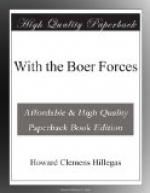very heels of the troops. The cannon at the drift
joined in the attack on the horsemen scattered over
the slope, and the big guns at the waterworks continued
to reply vigorously. The men in the spruit were
watching the artillery duel intently as they sped
up and down the bottom of the water-less stream, searching
for points of vantage. A large number of them
moved rapidly down the spruit towards its confluence
with the Modder River in order to check the advance
of the troops driven forward by the shell-fire, and
another party rushed eastward to secure positions in
the rear of the British cannon at the waterworks.
The banks of the stream still concealed them, but
they dared not fire lest the enemy should disturb
their plans. On and on they dashed, over rocks
and chasms, until they were within a few hundred yards
of a part of the British force. Slowly they crept
up the sides of the spruit, cautiously peered out over
the edge of the bank and then opened fire on the men
at the cannon and the troops passing down the slope.
Little jets of dust arose where their bullets struck
the ground, men fell around the cannon, and cavalrymen
quickly turned and charged toward the spruit.
The shells of the cannon at the drift and on the southern
hills fell thicker and thicker among the troops and
the air above them was heavy with the light blue smoke
of bursting shrapnel. The patter of the Boer
rifles at the spruit increased in intensity and the
jets of brown dust became more numerous. The
cavalrymen leaped from their horses and ran ahead to
find protection behind a line of rocks. The intermittent,
irregular firing of the Boers was punctuated by the
regular, steady reports of British volleys. The
brown dust-geysers increased among the rocks where
the British lay, and soon the soldiers turned and
ran for their horses. Burghers crept from rock
to rock in pursuit of them, and their bullets urged
the fleeing horsemen on. The British cannon spoke
less frequently, and shells and bullets fell so thickly
around them that bravery in such a situation seemed
suicidal, and the last artilleryman fled. Boers
ran up and turned the loaded guns upon the backs of
those who had operated them a few moments before.
Down in the north-western part of the field a large
force of troops was dashing over the veld toward the
banks of the spruit. Officers, waving swords
above their heads and shouting commands to their subordinates,
led the way. A few shells exploding in the ranks
scattered the force temporarily and caused horses
to rear and plunge, but the gaps quickly disappeared,
and the men moved on down the slope. Boers rode
rapidly down the spruit and out upon the veld behind
a low range of kopjes which lay in front of the British
force. Horses were left in charge of native servants,
and the burghers crept forward on hands and knees to
the summit of the range. They carefully concealed
themselves behind rocks and bushes and waited for
the enemy to approach more closely. The cavalrymen




